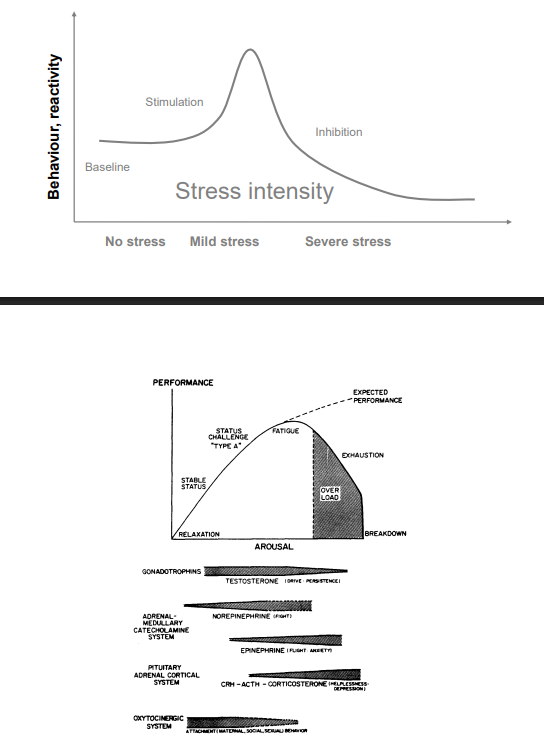HET301 L2: Stress models
What is a model?
Something that reflects or describes a certain aspect of reality
Simplified with respect to the functioning counterpart integrated in the actual world
Models in biology
Itemised description of a complex system
Functional theoretical framework
Mathematical formulation of numerical relationships or statistical links
Model organisms
1/39
Earn XP
Description and Tags
h
Name | Mastery | Learn | Test | Matching | Spaced |
|---|
No study sessions yet.
40 Terms
What is a model?
Something that reflects or describes a certain aspect of reality
Simplified with respect to the functioning counterpart integrated in the actual world
Models in biology
Itemised description of a complex system
Functional theoretical framework
Mathematical formulation of numerical relationships or statistical links
Model organisms
What is stress - classic definition
Living organisms survive by maintaining a complex dynamic equilibrium, homeostasis
internal and externalf factors threaten and disturb this state
threatened homeostasis leads to
stresss
stressor
anything that disrupts physiological balance
stress-response
the body’s attempts to re-establish balance
modern definition of stress
a condition in which a threat to the biological functions of an organism is perceived by that organism, and a set of physiological and behavioural responses is mounted to counteract this challenge
Studying stress/stress models: typical stressors in animals
Wild animals
predators, environemtnal stress (temperature, water quality), competition
(food scarcity and nutritional stress, parasites and disease, human disturbance)
Captivity
Handling and transport, vaccines, social stress (crowding, agression)
(physical environment, dietary stress, medical interventions, human interactions, sensory stressors, boredom and behavioural frustration)
The other animals of the same species can be a main stressor in both nature and captivity
Why study stress in animals?
Physiological and behavioural mechanisms of great importance to survival
Evolutionary conserved responses - model to explain the biological background of human diseases e.g. depression
Concern for animal welfare is increasing
Affects productivity and economogy of animal rearing operations
Stress - history
Walter Bradford Cannon
Coined the term fight or flight to describe an animal’s response to threats
The homeostasis concept
Found that also physiological emergencies evoke release of adrenaline into the bloodstream
Stress - history
Hans Selye
Stress - the nonspecific response of the body to any demand
General adaptation syndrome
Three phases: alaarm, resistance/adaptation, exhaustion
Distress and eustress
Stress - history
John Wayne Mason
Psychological influences on the pituitary-adrenal cortex system
Re-evaluation of the concept of non-specificity in stress theory
Stress - history
Robert Sapolsky
Psychosocial activation of the stress response
Social hierarchies
Effects of long-term stress
Stress - history
Bruce McEwen
Stress and the brain
The allostasis concept
Stress - history
Jaap Koolhaas
Individual stress coping styles
The physiolgoical response itself does not necessarily indicate stress
Cognitive perception of uncontrollability and/or unpredictability is the key factor
Stress should be restricted to those instances when the organism cannot respond and readjust to change
Psychological components of stress: predictability
Experiment with rats
Rat 1: put into apparatus but received no shock. Therefore the amount of stress exhibited by this rat is a measure of the stressfulness of being constrained in the test appratus
Rat 2: received a warning signal before shock
Rat 3: yoked to rat 2. Rats 2 and 3 received exactly the same number of shocks, but 3 received no warning signal before shock.
Results:
rats in the no shock group showed a small amount of ulceration
Rats given signalled shock had an intermediate amount of ulceration
Rats that were unable to predict shock showed significantly greater stomach ulceration
Conclusion
a psychological factor - predictability must be responsible for difference between these groups
Psychological components of stress: control
Experiments with rats
Rat 1 put into apparatus but received no shock
Rat 2 could avoid and escape shock by pressing lever. Therefore this rat can use a coping response to control shock delivery
Rat 3 yoked to rat 3. Received shock when rat 2 failed to emit and avoidance or escape response. Rat 3 could not avoid or escape shock
Results
Rats in the no shock group showed a small amount of ulceration
Rats that were able to use a coping response to control shock showed an intermediate stress response
Rats with no control over shock delivery had significantlhy greater stomach ulceration thatn rats that received exactly the same amount of electric shock but were able to avoid or escape from it
Conclusin
a psychological factor - control- must be responsible for difference between these groups
(human studies: it is not the actual control that counts, but the perceived control)
Key points
Stress level is determined by
What actually occurs, what the brain registers, what is expected occur
Predictability and control reduces stress
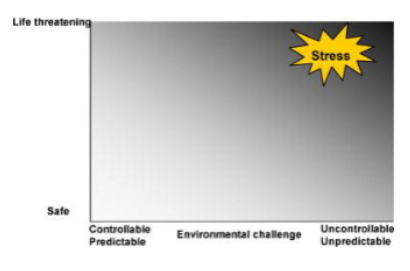
The synapse in action - multiple levels of control and plasticity
Synapse numbers: neural pathways - brain architecture
Synthesis and storage of neurotransmitter molecules in synaptic vessels
Levels of precursors, enzymes to synthesize
Release of neurotransmitter molecules into synaptic cleft
Arriving action potentials
Binding of neurotransmitters at receptor sites on postsynaptic membrane
Receptor number and type depend on previous use, hormones etc.
Inactivation (by enzymes) or removal (drifting away) of neurotransmitters
Enzymes to break down
Reuptake of neurotransmitters sponged up by the presynaptic neuron
Rreuptake mechanism
Types of stress
Postiive stress
Tolerable stress
Toxic stressP
Positive stress
A personal challenge that has a satisfying outcome
Result: sense of mastery and control
Healthy brain architecture
Good self-esteem, judgement and impulse controlT
Tolerable stress
Adverse life events buffered by supportive relationships
Result: coping and recovery
Healthy brain architecture
Good self-esteem, judgement and impulse control
Toxic stress
Unbuffered adverse events of greater duration and magnitude
Result: poor coping and compromised recovery
Result: increased life-long risk for physical and mental disorders
Compromised brain architecture
Dysregulated physiological systems
The allostasis concept
Achieving stability through cahnge in anticipation of physiological requirements
Both the internal and external environemtn changes continuously in the allostasis concept
allostasis
allostatic load
allostasis: continuous readjustment
allostatic load: cost/magnitude of these changes
Homeostasis - definition
The stability of physiological systems that maintain life, used here to apply strictly to a limited number of systems such as pH, body temperature, glucose levels and oxygen tension that are truly essential for life and are therefore maintained within a range optimal for each life history stage
Allostasis - definition
Achieving stability through change, a process that supports homeostasis, i.e. those physiological parameters essential for life defined
Allostatic overload
Unpredictable, uncontrollable and chronic stressors accumulate so that normal adptation adn regulation fails
Possible outcomes of allostatic overload
Energy demand exceeds energy intake
problems not related to energy demand
metabolic imbalance
brain remodelling
heart remodelling
immune balance
this all leads to the inability to respond to further change and challenges → lack of coping
Enviornmental stressors engage brain systems that perceive the stressful situation, activating both behavioural respones and physiological responses
These responses can be shaped by individual differences that may arise from genetic polymorphisms or from experience (e.g. early life environment, cumulative exposures. The behavioural and physiologic responses are an integral component of allostatic responses which promote adaptation and also contribute to allostatic load. Long-term buildup of allostatic load can lead to allostatic overload and breakdown of this integrated set of responeses, promoting pathology
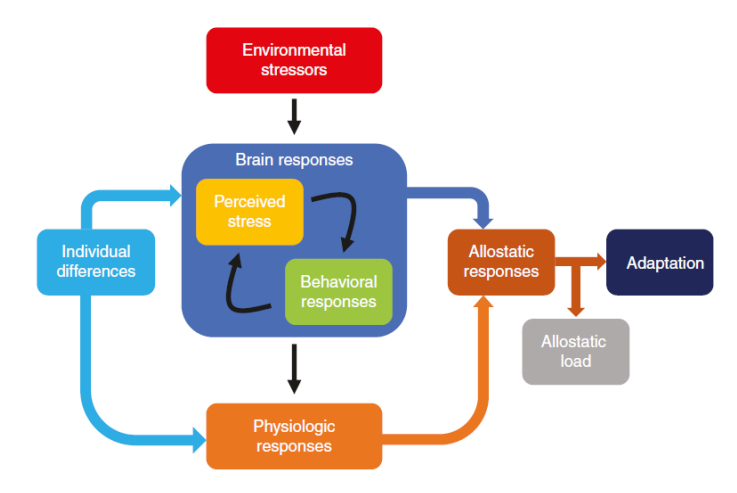
Living in a box - the concept of tolerance limits
Instruemnts the animal can use:
Migration, genomic adaptation, phenotypic plasticity (acclimation)
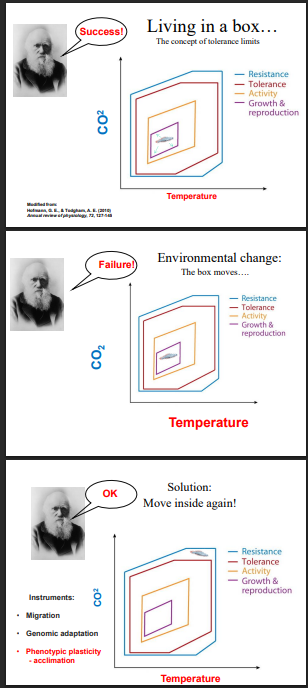
Stress response - stress and the HPA axis
Hypothalamus - CRH
Pituitary gland - ACTH
Adrenal glands (located above kidneys) - cortisol
The hypothalamus respons to levels of cortisol
reduces CRH if cortisol is high and increases CRH if cortisol is low
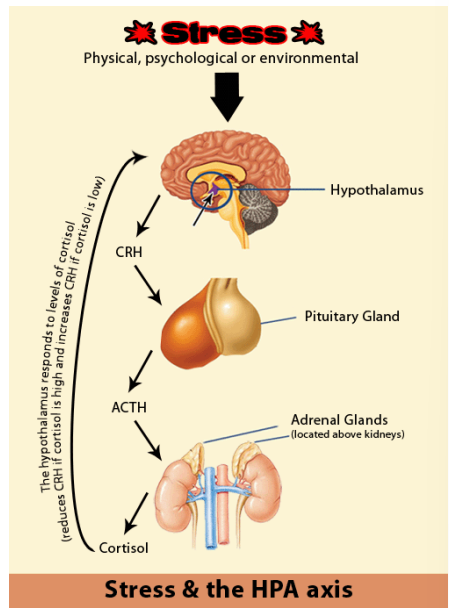
Physiological stress responses
the allostatic mediators: sympathetic branch of the autonomic nervous system
Epinephrine (Adrenaline)
binds to multiple receptors
Increases heart rate and stroke volume
Dilates the pupils
Constricts arterioles in the skin and gut
Increases catalyses of glycogen to gluocse in the liver
initiates breakdown of lipids in fat cells
Suppressive effect on the immune system
Cognitive effects: enhances memory formation
The hypothalamus=pituitary-adrenal (HPA) axis
Key elements of the HPA axis
the paraventricular nucleas of the hypothalamus
Synthesize and secrete corticotropin-releasing hormone (CRH) and vasopressin
The anterior lobe of the pituitary gland
CRH and vasopressin stimulate the secretion of adrenocorticotropic hormone ACTH
The adrenal cortex
produce glucocorticoid hormones in response to stimulation by ACTH
Negative feedback
Glucocorticoids act back on the hypothalamus and pituitary to suppress CRH and ACTH production
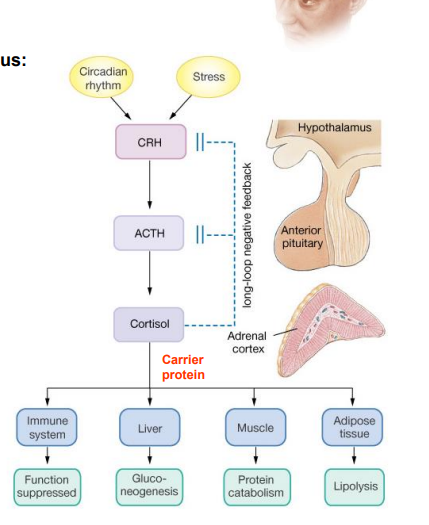
stress models
social stress in fishes (rainbow trout)
the trout/salmon model for social dominance
physiological and behavioural effects of social rank
fights for socail dominance in territorail rainbow trout
arena: glass aquaria with removable walls
fish: juvenile (30-150 g) trout moved from group rearing to isolation
isolation for 1 week with daily access to food creates territorial fish
dominance test: removal of walls between neighbouring fish
inactivity (10s-90m)
aggressive displays (0.5-5m)
fights: circling, attacks, biting (0.5-180m)
resolution/dominance: unilateral aggression (duration of the experiment)
Chronic stress effects in the salmon
Subordinate fish are int he periphery of the test arena
Subjected to unpredictable aggression
Reduced or completely inhibted feed intake
Completely inhbited aggressive behaviour after initial fights
Long lasting effects, even if removed from dominant individual
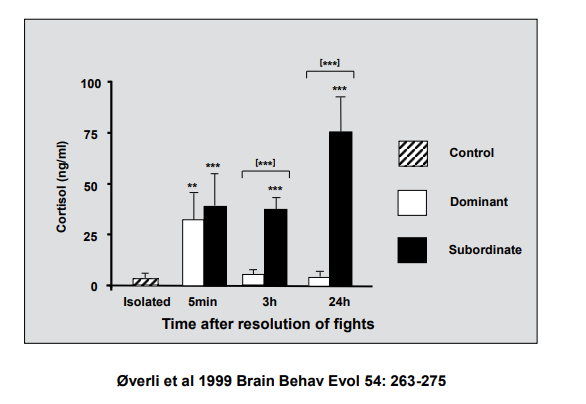
Chronic stress effects - rats
A stressor can be distinguished from a normal controllable situation by the recovery of the physiological response rather than the magnittidue of the response
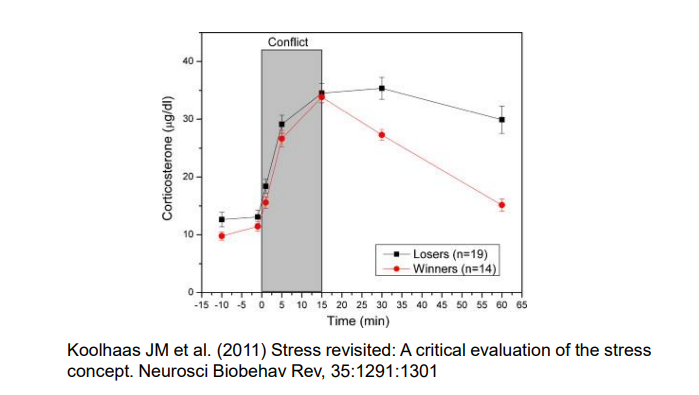
The concept of active and passive behavioural responses to stres
Acute:
fight or flight or active coping - an active attempt to counteract the stressor may or may not be mounted
milk, predictable, controllable stressorss
Chronic
conservation-withdrawal, or passive coping; inhbition of appetite, aggression, locomotion, reproduction
Why two types of responses?
At an early stage the severity of the stressor is not know, an active attempt to counteract it , may or not may be rewarded
During severe or chronic stress, decreased risk-taking, resource conservation and a wait and see strategy is more rewarding (if you can not do anything about it, why try?)
the threshold at which the shift between active and possive coping occurs is subject to large individual variation (risk-taking strategy vs stress-coping style)
behavioural effect of stress is highly dependent on dose and duration of exposure
